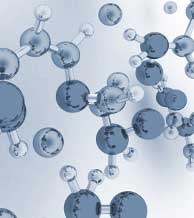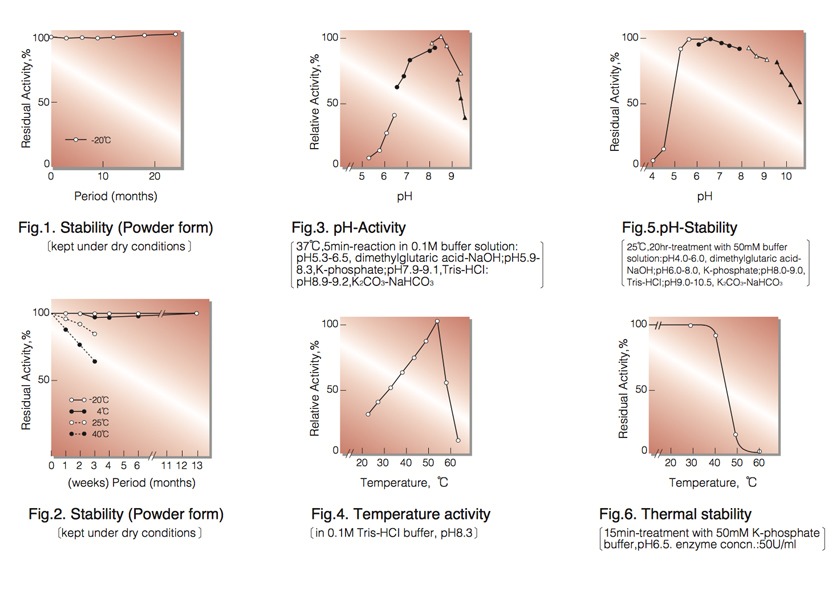D-3-HYDROXYBUTYRATE DEHYDROGENASE from Pseudomonas sp.
HBD-301
| Appearance: | White amorphous powder, lyophilized | ||
|---|---|---|---|
| Activity: | GradeⅢ 100U/mg-solid or more |
||
| Contaminants: | Malate dehydrogenase ≤2.0×10⁻³% Lactate dehydrogenase ≤2.0×10⁻³% NADH oxidase ≤2.0×10⁻³% |
||
| Stabilizers: | Sucrose, mannitol, BSA | ||
| Stability: | Stable at -20°C for at least Two years (Fig.1) |
|---|---|
| Molecular weight : | approx. 130,000 (by gel filtration) |
| Isoelectric point : | 5.6±0.1 |
| Michaelis constants : | 4.2×10⁻⁴M (25°C, pH8.3), 7.0×10⁻⁴M(37°C, pH8.3)(D-3-Hydroxybutyrate) 4.9×10⁻⁵M (25°C, pH8.3), 7.2×10⁻⁵M (37°C, pH8.3)(NAD⁺) 8.1×10⁻⁵M (25°C, pH7.1), 2.4×10⁻⁴M (37°C, pH7.1)(Acetoacetate) 8.4×10⁻⁶M (25°C, pH7.1), 1.5×10⁻⁵M (37°C, pH7.1)(NADH) |
| Inhibitors : | PCMB, MIA, IAA, Ag⁺, Hg⁺⁺, SDS, DAC |
| Optimum pH : | 8.3(Fig.3) |
| Optimum temperature : | 55°C(Fig.4) |
| pH Stability : | pH 5.0-8.5 (25°C, 20hr)(Fig.5) |
| Thermal stability : | below 40°C (pH 6.5, 15min)(Fig.6) |
| Substrate specificity : | (Table 1) |
| Effect of various chemicals: | (Table 2) |
APPLICATIONS
This enzyme is useful for enzymatic determination of ketone bodies (D-3-hydroxybutyrate and acetoacetate) in clinical analysis.
ASSAY
Principle:
D-3-hydroxybutyrate dehydrogenase
D-3-Hydroxybutyrate+NAD⁺ ► Acetoacetate+NADH+H⁺
The appearance of NADH is measured at 340nm by spectrophotometry.
Unit definition:
One unit causes the formation of one micromole of NADH per minute under the conditions described below.
Method:
| A. Tris-HCl buffer, pH 8.5 (25°C) : | 0.1M |
|---|---|
| B. 3-Hydroxybutyrate solution: | 158mM[200mg D,L-3-Hydroxybutyrate Na salt (MW=126.09)/10ml of Tris-HCl buffer (A)](Stable at least 5 days if stored at 4°C) |
| C. NAD⁺ solution: | 27.9mM[80mg NAD⁺・3H₂O (MW=717.45)/4.0ml of Tris-HCl buffer (A)] (Stable for at least 5 days if stored at 4°C) |
| D. Enzyme diluent: | 0.1M Tris-HCl buffer, pH 8.5 contg. 0.1% BSA |
Procedure
| Concentration in assay mixture | |
|---|---|
| Tris-HCl buffer | 0.1 M |
| 3-Hydroxybutyrate | 25 mM |
| NAD⁺ | 1.8mM |
1. Prepare the following reaction mixture in a cuvette (d=1.0cm) and equilibrate at 37°C for about 5 minutes.
2.3 ml Tris-HCl buffer, pH 8.5 (A)
0.5 ml Substrate solution (B)
0.2 ml NAD⁺ solution (C)
2. Add 0.1ml of the enzyme solution* and mix by gentle inversion.
3. Record the increase in optical density at 340nm against water for 2 to 3 minutes in a spectrophotometer
thermostated at 37°C and calculate the ΔOD per minutes from the initial linear portion of the curve (ΔOD test).
At the same time, measure the blank rate (ΔOD blank) by using the same method as the test except that the enzyme diluent is added instead of enzyme solution.
* Dissolve the enzyme preparation in ice-cold enzyme diluent (D), dilute to 0.1-0.5U/ml with the same buffer and store on ice.
Calculation
Activity can be calculated by using the following formula :

ΔOD/min (ΔOD test−ΔOD blank ) ×Vt × df
Volume activity (U/ml) = =ΔOD/min×4.98×df
6.22×1.0×Vs
Weight activity (U/mg)=(U/ml)×1/C
- Vt
- : Total volume (3.1ml)
- Vs
- : Sample volume (0.1ml)
- 6.22
- : Millimolar extinction coefficient of NADH at 340nm (㎠/micromole)
- 1.0
- : Light path length (cm)
- df
- : Dilution factor
- C
- : Enzyme concentration in dissolution (c mg/ml)
REFERENCES
- H.U.Bergmeyer, K.Gawehn, H.Klotzsh, H.A.Krebs and D.H.Williamson; Biochem.J., 102, 423 (1967).
- F.P.Delafield, K.E.Cooksey and M.Doudoroff; J.Biol.Chem., 240, 4023 (1965).
- C.W.Shuster and M.Doudoroff; J.Biol.Chem., 237, 603 (1962).
- I.Sekuzu, P.Jurtshuk and D.E.Green; J.Biol.Chem., 238, 975 (1963).
- J.D.Smiley and G.Ashwell; J.Biol.Chem., 236, 357 (1961).
| Substrate | Relative activity(%) | Substrate | Relative activity(%) |
|---|---|---|---|
| 3-Hydroxybutyrate | 100 | sec-Butyl alcohol | 0 |
| 3-Hydroxypropionate | 0.14 | Gluconate | 0 |
| Lactate | 0 |
Glycolate | 0.04 |
| Glycerate | 0 |
||
| 2-Hydroxybutyrate | 0 | NAD⁺ | 100 |
| L-Malate |
0 | NADP⁺ | 4.74 |
| D,L-Malate | 0 |
| Chemical | Concn.(mM) | Residual activity(%) |
Chemical | Concn.(mM) | Residual activity(%) |
|---|---|---|---|---|---|
| None | − | 100% | NaF | 2.0 | 100 |
| Metal salt | 2.0 | NaN₃ |
20 | 104 | |
| MgCl₂ | 105 | EDTA | 5.0 | 97 | |
| CaCl₂ |
101 | o-Phenanthroline | 2.0 | 96 |
|
| Ba(OAc)₂ | 98 | α,α′-Dipyridyl | 1.0 | 97 | |
| FeCl₃ | 101 | Borate | 50 | 103 | |
| CoCl₂ | 102 | IAA | 2.0 | 4 |
|
| MnCl₂ | 103 | NEM | 2.0 | 59 | |
| ZnSO₄ | 100 | Hydroxylamine | 2.0 | 101 | |
| Cd(OAc)₂ | 100 | Triton X-100 | 0.10% | 113 | |
| NiCl₂ | 103 | Brij 35 |
0.10% | 37 | |
| CuSO₄ | 83 | Tween 20 | 0.10% | 68 | |
| Pb(OAc)₂ | 96 |
Span 20 | 0.10% | 104 | |
| AgNO₃ | 2.5 | Na-cholate | 0.10% | 107 | |
| HgCl₂ | 0 | SDS |
0.05% | 5 | |
| PCMB | 2.0 | 0 | DAC | 0.05% | 4 |
| MIA | 2.0 | 1 |
Ac, CH₃CO; PCMB, p-Chloromercuribenzoate; MIA, Monoiodoacetate; EDTA, Ethylenediaminetetraacetate; IAA, lodoacetamide; NEM, N-Ethylmaleimide; SDS, Sodium dodecyl sulfate; DAC, Dimethylbenzylalkylammonium chloride.

To get a quote, contact us at info@toyobousa.com, or INQUIRY.
